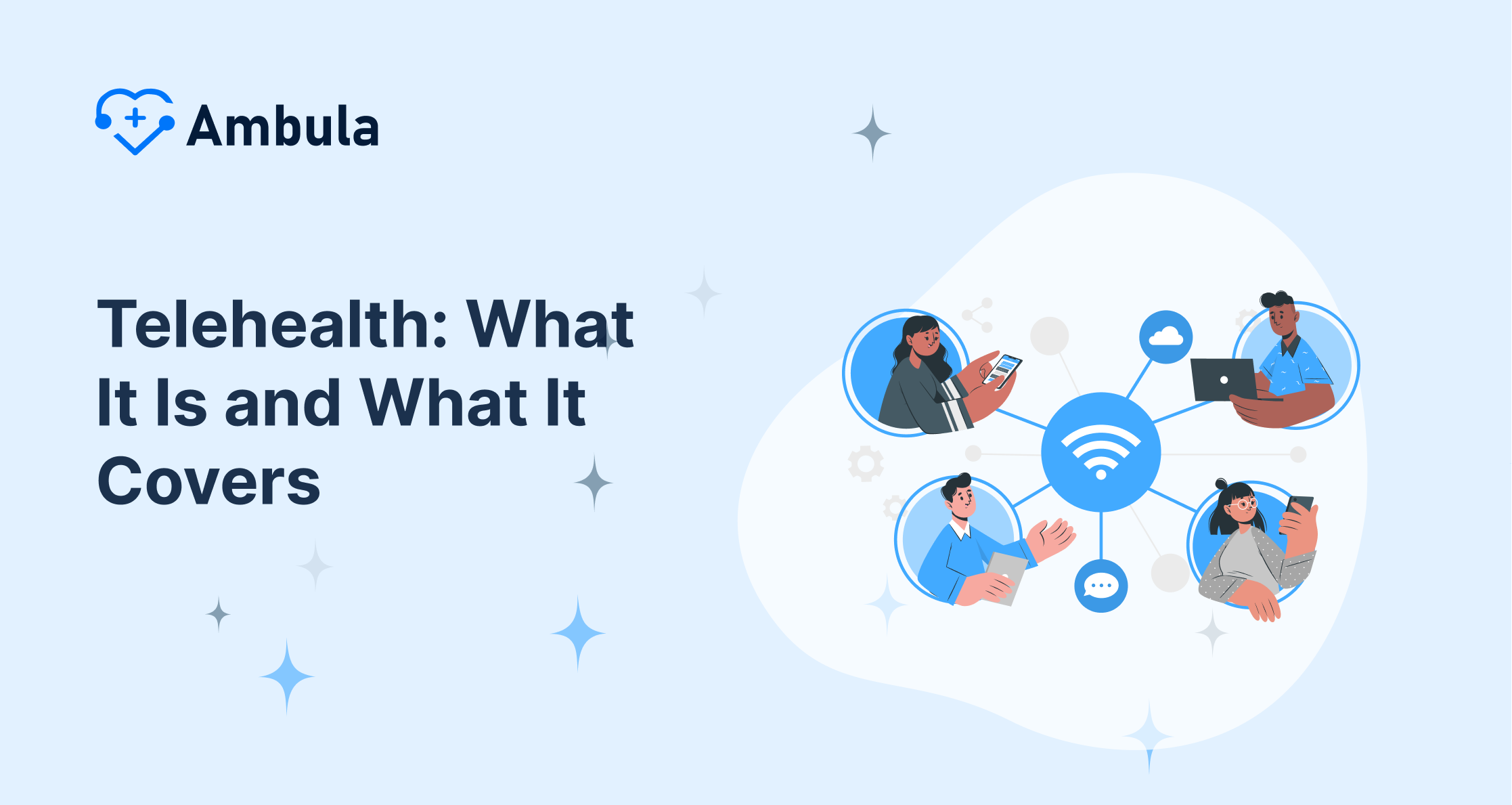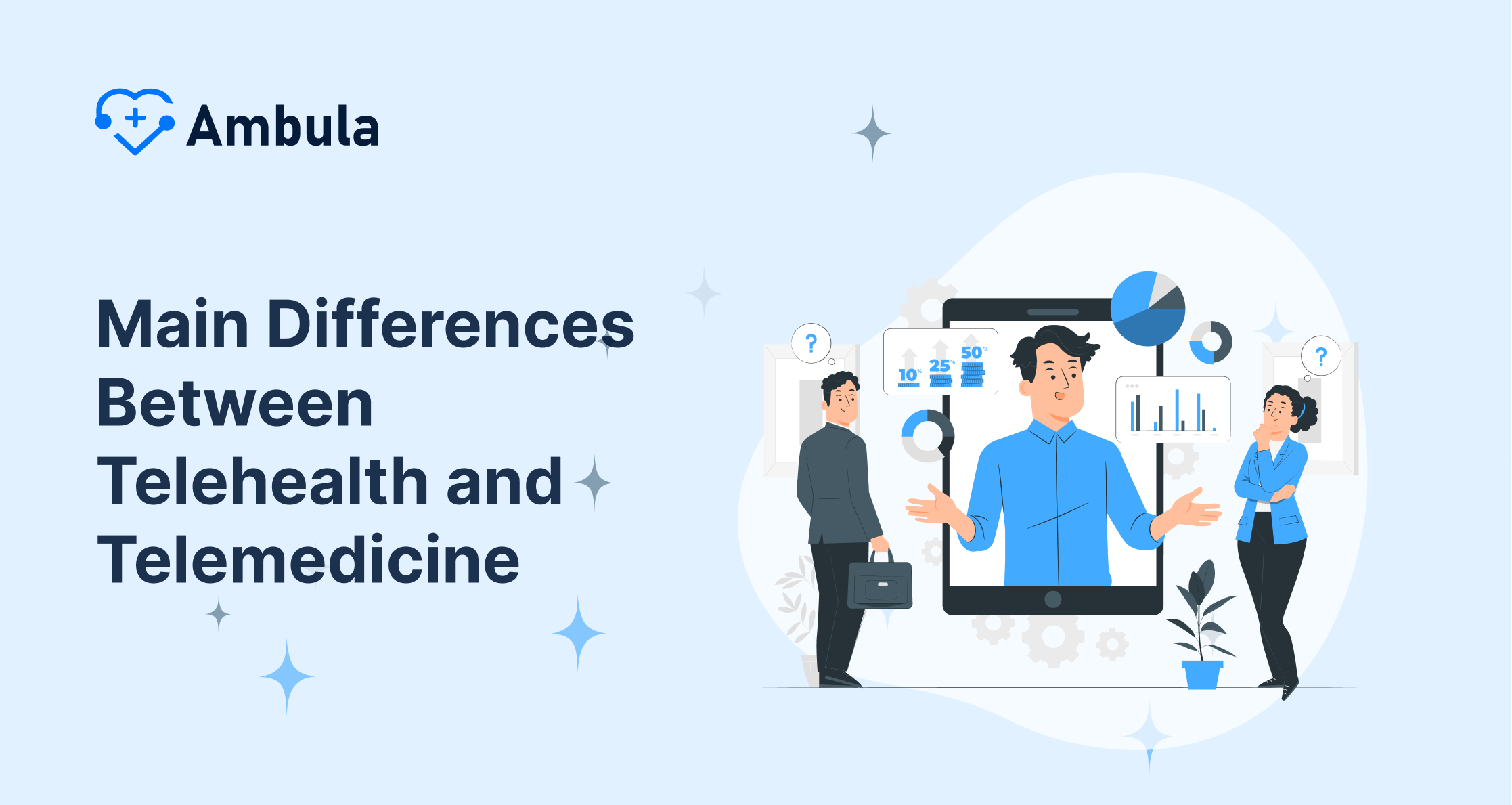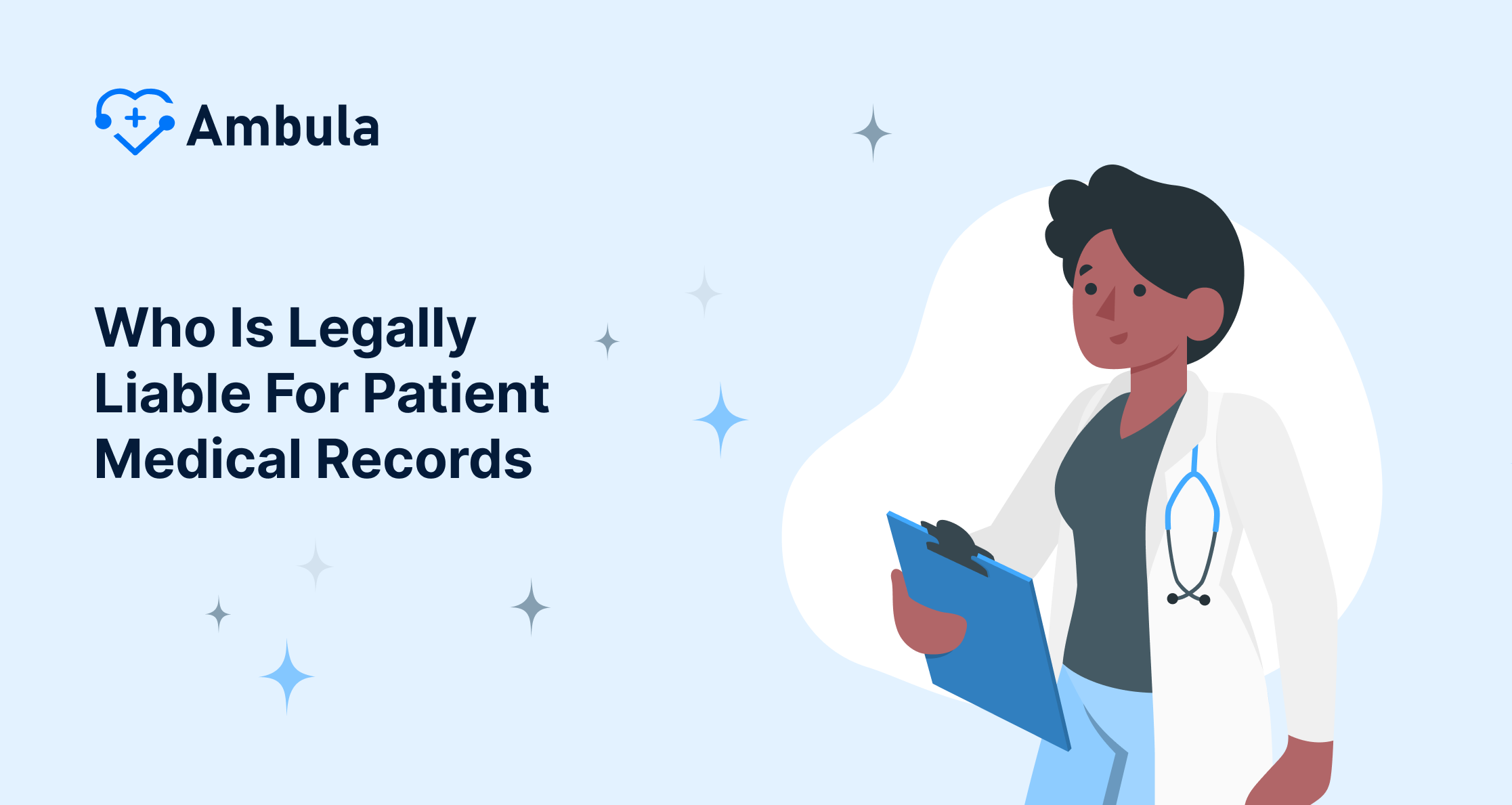In the fast-changing world of healthcare, tech has brought about two big ideas: Telehealth and Telemedicine. People often think they’re the same thing, but they’re not. It’s super crucial for patients, doctors, and people who make the rules to differentiate between Telehealth and Telemedicine. Each has its job in making healthcare easier, helping patients and doctors talk better, and bringing in new digital health stuff. Knowing what sets them apart affects how insurance covers telehealth and telemedicine. It also shapes the rules, the tech they need, and how doctors use them to help people from far away.
This article wants to clear up the often-mixed-up words by defining Telehealth and Telemedicine, looking at what they cover, and showing the main things that make them different. We’ll check out how CMS defines telehealth vs telemedicine and what this means for preventive care help non-medical services, as well as far-away medical services. We’ll see how these digital health methods change medical care. Also, we’ll look at real-life examples and go over the good things they offer, like how handy telehealth is, Medicare telehealth services, and ways to use telemedicine. This talk will help you understand how these online care systems are making healthcare easier, more efficient, and better overall.
Telehealth: What It Is and What It Covers
Getting to Know Telehealth
Telehealth uses tech stuff to help people get healthcare from far away and take care of their health 1. This big idea covers a bunch of tech things like video calls, internet, and streaming. Telehealth isn’t just about giving direct medical help. It also helps with long-distance healthcare, teaching patients and doctors about health stuff, public health, and running health services.
Telehealth has grown a lot since COVID-19 hit. Now, doctors and patients often meet online. These services help in places where it’s hard to see a doctor in person. They use gadgets to check things like blood pressure and heart rate from far away. Also, telehealth makes it easier for doctors in small towns to get help from big-shot specialists elsewhere. This means patients get better care.
Non-clinical Services Involved
Telehealth has an impact on many non-clinical services that are essential to the healthcare system. These services include stuff like training providers holding administrative meetings, and continuing medical education. The Health Resources Services Administration points out that telemedicine focuses on remote clinical services, while telehealth covers these extra non-clinical services too, which play a big part in the healthcare world 2.
Also, doctors use telehealth tech to keep an eye on patients from afar. This lets them gather and check out patient info outside regular doctor’s offices 2. This part of telehealth helps people with long-term health issues or those who need to be watched all the time.
Telehealth is changing how we do healthcare every day. It has a big influence on making it easier to see specialists cutting down on trips to the doctor’s office, and making things more convenient for patients. It also helps to teach people about health by giving them access to info and stuff that can make them healthier 1. All these things show how telehealth is causing a revolution in modern healthcare and how much it can do.
Telemedicine: What It Is and What It Covers
Getting to Know Telemedicine
Telemedicine uses electronic info and tech for communication to give and back up healthcare when people are far apart. This covers a wide range of tech from simple phone calls to complex remote surgery where docs control robots to operate. The main thing about telemedicine is that it links patients with healthcare folks through tech helping to close the gap caused by how far apart they are.
Telemedicine goes beyond just real-time chats. It also uses ‘store and forward’ tech to send medical stuff like X-rays for doctors to check later. This makes it easier to get healthcare to people even in far-off places. Telemedicine has grown to include things like virtual visits keeping an eye on patients from afar, and talking to patients by video or phone.
Clinical Services Involved
Telemedicine covers lots of clinical services that help make patient care better. These include video calls in real-time for urgent talks keeping an eye on important health info like blood pressure and heart stats from far away, and the store-and-forward way, which is about sharing medical files and test results for more looking into. Doctors use these services to give patients better care without them having to come in person all the time.
Telemedicine can work well in many different areas of medicine. This makes it pretty useful. For example, skin doctors can look at high-quality pictures to check out skin problems. Mental health experts can talk to patients through safe video calls. Telemedicine also helps regular doctors to keep an eye on their patients. This means patients can get help when they need it.
The need for safe and easy-to-access patient care has sped up the use of telemedicine in health systems. This became super clear during COVID-19. Doctors and hospitals started to use telemedicine fast to lower the chance of getting sick, save resources, and keep treating patients no matter where they were.
Telemedicine has a bunch of uses and makes things easier. It helps with medical stuff and makes healthcare work better overall. Using tech in medicine has turned out to be key to keep treating patients and to let more people in different places get healthcare.
Main Differences Between Telehealth and Telemedicine
Tech They Use
Telehealth and Telemedicine both use digital tech to make healthcare better, but they’re pretty different in how they use it. Telehealth covers more ground using all sorts of tech and services to help with healthcare from far away. It’s not just about treating patients. Telehealth includes stuff like devices that keep track of your health, apps on your phone for health stuff, and ways to learn about health online.
On the flip side, Telemedicine zeroes in on giving remote clinical care. It uses safe audio and video links to make real-time talks between patients and doctors possible. This covers things like yearly checkups writing prescriptions, and online urgent care talks.
Types of Services Provided
Telehealth has a bunch of services that go beyond just taking care of patients. It also includes stuff like training doctors managing health stuff, and teaching people about health . For instance, telehealth lets doctors watch online lectures to keep learning and join meetings through video calls. This shows how telehealth helps to make the whole healthcare system better and supports health education.
On the other hand, Telemedicine deals with clinical services that involve taking care of patients. This includes remote check-ups, follow-up visits, and managing long-term health issues, which doctors deliver using technology to communicate from afar. People often use Telemedicine services to keep an eye on patient health after surgery or during ongoing treatment for lasting health problems showing how important it is for keeping patients healthy over time.
The differences in tech and services that Telehealth and Telemedicine offer show how they each play their own part in healthcare even though they work together. Telemedicine focuses on taking care of patient’s medical needs right away. On the other hand, Telehealth provides a wider range of help that adds to managing health and teaching people over time.
Telehealth and Telemedicine in Action
How It’s Used in Real Life
Telemedicine has grown fast in radiology. Teleradiology lets doctors send x-rays and scans for advice. It’s one of the most common types of telemedicine. From 1990 to 1995, it doubled every year . This happened because radiology started using digital pictures on. They also had a system for getting help that used to depend on mailing stuff . Telemedicine has also helped prisoners to see specialists. This saves money and helps them get care faster .
Stanford University Medical Center has come up with a cool program to keep an eye on patients after surgery. What’s interesting is they’re doing this without any money from the government, which shows how telemedicine can work when people take charge. Also, big health systems like Allina in Minnesota are checking out how telemedicine can make their care better, even in places far from cities.
Use Cases
Telehealth has grown a lot making things easier for patients and doctors. It lets people have doctor’s visits online, which means they don’t have to wait forever or risk getting sick in packed waiting rooms. This helps folks in the countryside, who can now get medical care without having to drive for hours.
Telehealth has specific ways people use it. One way is to keep an eye on patients from far away. This lets doctors check important health info without the patient coming in. It’s super helpful to manage long-term health problems like diabetes and high blood pressure during pregnancy. Another cool use is for physical therapy. Patients can do their exercises with a therapist watching over video calls. This is great for folks who need to work on getting better but can’t go to the doctor’s office all the time.
What’s more, telehealth has shown to be good at closing gaps in care for people with dementia. When COVID-19 hit, telehealth became a good option instead of face-to-face care. This was really important for folks with dementia and the people looking after them. This change highlights how telehealth helps to tackle unfair differences in healthcare and makes patient care better in many medical and non-medical areas.
Conclusion
In this article, we’ve looked at the differences between Telehealth and Telemedicine showing how they each play a special part in making healthcare better with tech. We checked out what they mean, what they cover, and the big things that set them apart. We also saw how they work together to make it easier for people to get healthcare. These digital health tools have changed how we do healthcare, from doing doctor visits online to giving help with learning and paperwork. They’ve made healthcare easier to get, quicker, and more focused on what patients need.
Understanding and telling apart Telehealth and Telemedicine is super important as healthcare keeps changing to deal with today’s problems. These technologies have a huge impact on how healthcare is given, so it’s important for doctors people who make rules, and patients to get these differences. As we go forward, putting Telehealth and Telemedicine into our healthcare system is a big step towards making healthcare easier for everyone to get. This shows we need to study and use these things more.
FAQs
1. What sets telehealth apart from telemedicine?
Telemedicine has to do with giving clinical services from far away. Telehealth though, covers more ground. It includes remote clinical services and other stuff like training providers holding admin meetings, and keeping doctors up to date with their education.
2. How does Quizlet explain the difference between telehealth and telemedicine?
Quizlet says telehealth is about using electronic info and tech to help with a bunch of services. These include healthcare over long distances, teaching patients and doctors about health, public health stuff, and running health systems. On the flip side, telemedicine is just about swapping medical info between different places to figure out what’s wrong and how to treat it.
3. What is the correct statement that differentiates telehealth from telemedicine?
Telehealth covers a wide range of virtual services, both clinical and non-clinical. Telemedicine, on the other hand, focuses on providing medical diagnosis and treatment.
4. Are the terms telehealth and telemedicine interchangeable?
The American Telemedicine Association (ATA) thinks of telehealth and telemedicine as the same thing. They see both as covering many types of remote healthcare. But it’s good to remember that telehealth doesn’t always involve direct medical care.
References
[1] – https://www.mayoclinic.org/healthy-lifestyle/consumer-health/in-depth/telehealth/art-20044878[2] – https://www.healthit.gov/faq/what-telehealth-how-telehealth-different-telemedicine[3] – https://www.nibib.nih.gov/science-education/science-topics/telehealth[4] – https://www.ncbi.nlm.nih.gov/books/NBK45440/[5] – https://www.hopkinsmedicine.org/health/treatment-tests-and-therapies/benefits-of-telemedicine






